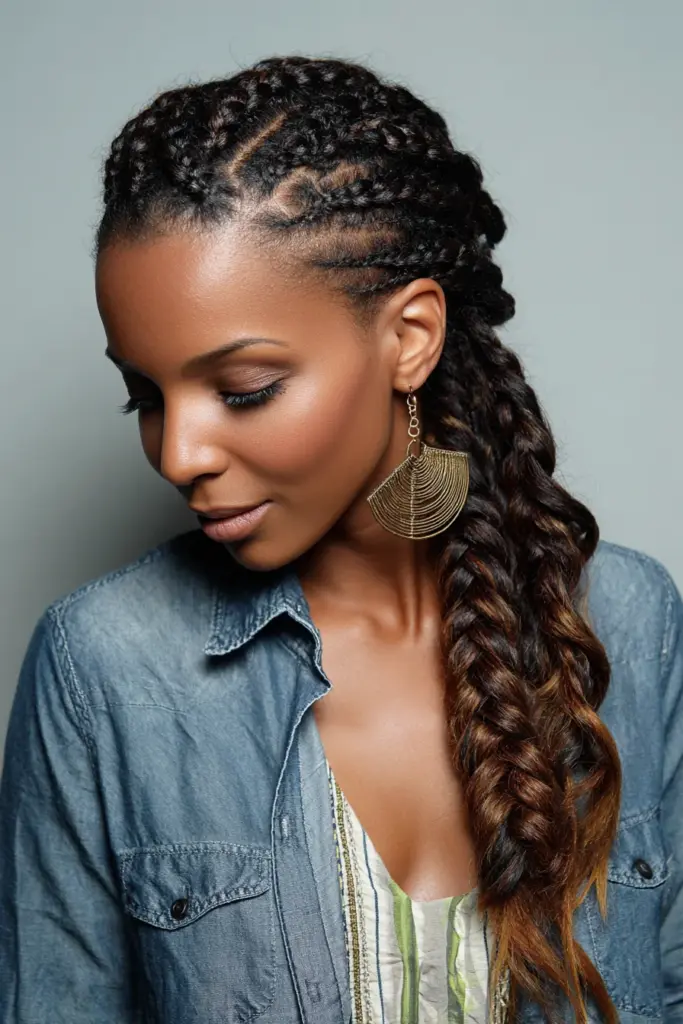Hi, Im Lena — a hairstylist with over a decade of salon experience specializing in braid work and textured hair. In this post I showcase nine versatile braided hairstyles for women, from everyday looks to special-occasion updos. These styles suit a wide range of hair types and lengths: fine hair benefits from added texture and padding, medium hair holds classic French and Dutch braids beautifully, and thick or curly hair creates bold, long-lasting box braids and cornrows. I designed each look to be achievable at home or by a stylist, and the nine accompanying images illustrate step-by-step shapes and finishing details. Styling tips you can use right away: prep with a light texturizing spray for grip, use small elastics and protective oils to seal ends, and practice tension control to keep hair healthy. Read on to find the perfect braid for your face shape and lifestyle.
Textured Side Cornrows with Long Micro Braids and Low Braided Bun
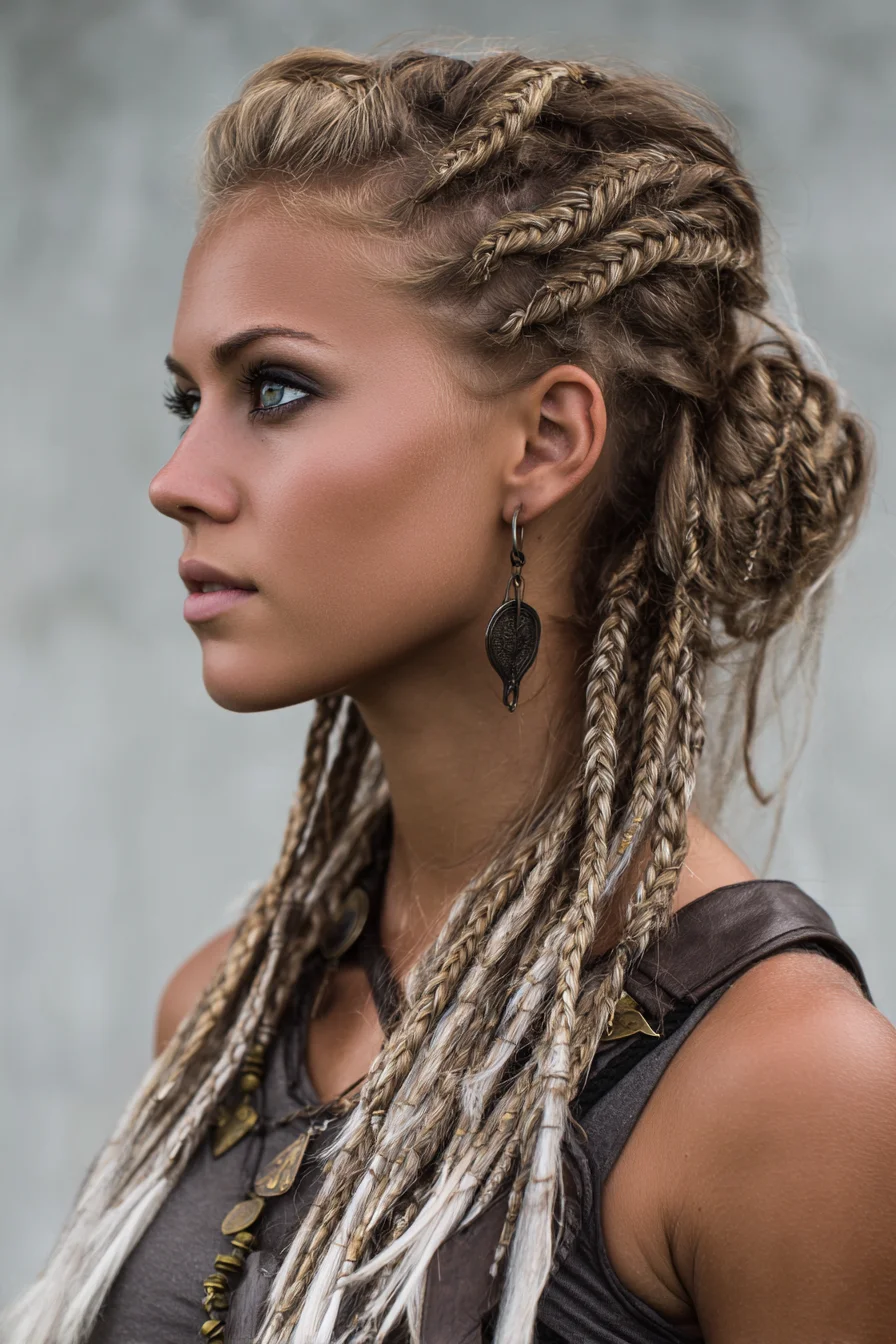
This polished boho look combines neat side cornrows that feed into long textured micro braids, finished in a low braided bun. Suitability: ideal for medium to coarse natural hair and long lengths; fine hair works well when reinforced with lightweight braiding extensions. Styling technique: section the sides into clean parts with a rat-tail comb, apply a leave-in and texturizing spray, then create feed-in cornrows at the hairline and transition to small three-strand micro braids down the length. Gather surplus braids into a loose low bun and secure with pins for shape. Tools needed: rat-tail comb, sectioning clips, small elastics, hairpins, crochet needle (optional for extensions), and a soft-bristle brush. Products required: leave-in conditioner, texturizing powder or paste, edge control gel, light-hold hairspray, and a lightweight anti-frizz serum. Difficulty level: intermediate–advanced; expect 2–4 hours depending on braid size and extensions. Maintenance tips: sleep on a silk scarf or bonnet, lightly mist scalp with a diluted leave-in weekly, wash gently every 2–4 weeks, avoid excessive tension, and re-tighten cornrows as needed to prevent breakage.
Double Dutch Braids: Crown-to-Nape Braided Pigtails

An elevated, slightly undone double Dutch braid that starts at the hairline and continues crown-to-nape into two braided pigtails. Suitable for straight to wavy hair and medium to thick textures; fine hair can wear this style with added texture or light extensions for fullness. Technique: create a clean center part, section one side and begin an inside-out (Dutch) braid by crossing outer strands under the center, adding small sections with consistent tension, braid to the nape and finish with a secure elastic; repeat on the other side. Tools: rat-tail comb, sectioning clips, small clear elastics, boar-bristle brush and tail comb. Products: texturizing spray or dry shampoo for grip, light styling cream or smoothing balm for flyaways, flexible-hold hairspray. Difficulty: moderate — requires practice to keep even tension and symmetry; allow 20–30 minutes. Maintenance: sleep on a silk pillowcase or wrap with a scarf, refresh with a mist of water and texture spray, gently re-tighten or pin loose pieces, and avoid heavy brushing to keep braid definition and reduce frizz.
Half-Up Long Box Braids with Side-Swept Crown
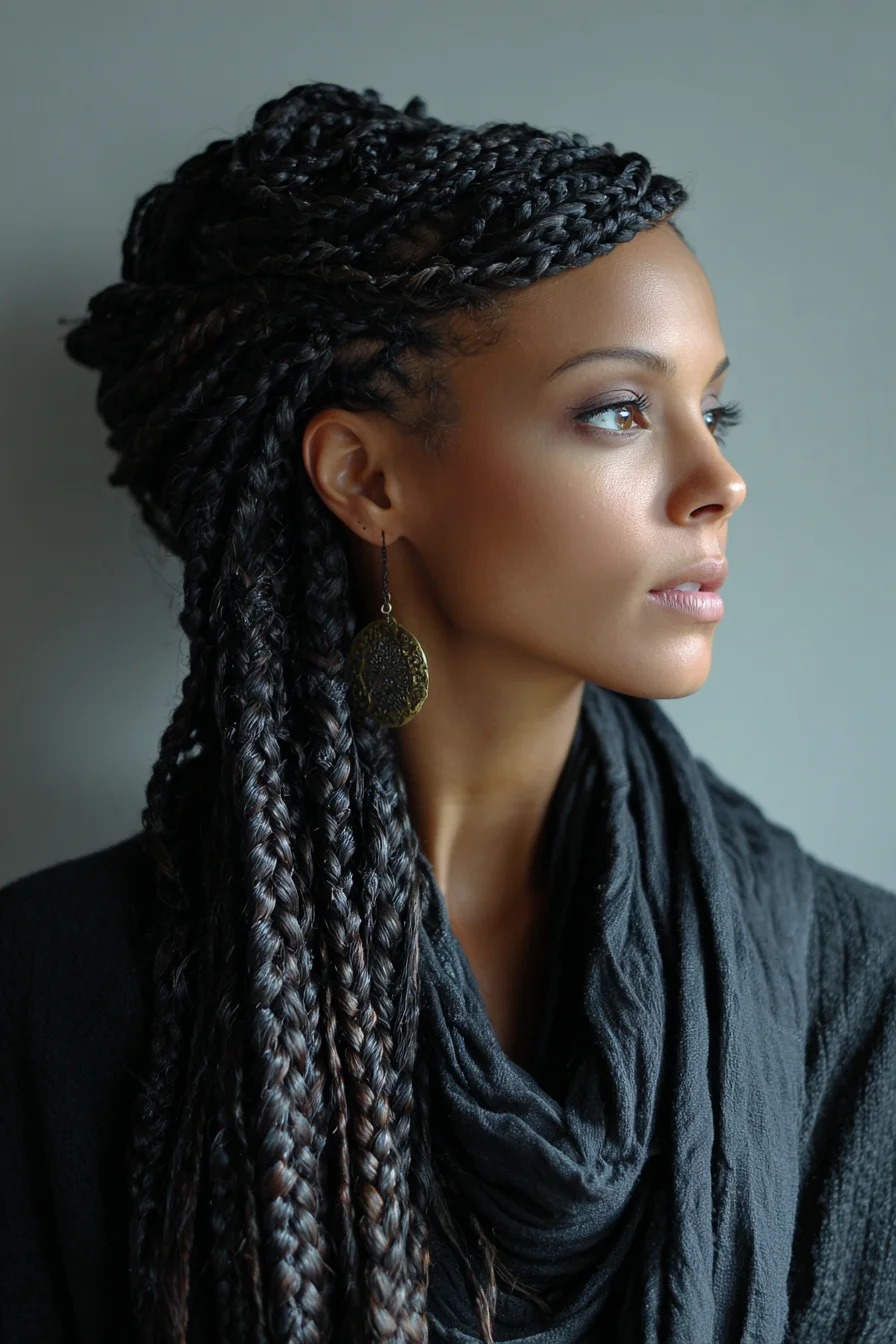
Suitable for medium-to-coarse natural hair and for clients using extension hair, this half-up, side-swept box braid offers a polished protective style. Technique: install medium-to-small box braids or individual three-strand braids across the head, then section a crown piece from temple to temple, sweep it back, secure with an elastic or pins and wrap a few braids around the base to conceal fastenings. Tools needed: rat-tail comb, sectioning clips, braiding hair (optional), small elastics, bobby pins and a crochet needle for tidy touch-ups. Products required: hydrating leave-in conditioner, lightweight scalp oil or serum, edge control for baby hairs, a light-hold mousse to tame frizz and dry shampoo for in-between washes. Difficulty level: Moderate — neat installation is time-consuming (expect 4–8 hours) and a professional stylist is recommended for uniform tension and longevity. Maintenance tips: sleep on a satin bonnet or pillowcase, re-moisturize the scalp weekly, refresh edges as needed, wash gently every 2–3 weeks with diluted shampoo and dry thoroughly. Remove braids after 6–8 weeks to avoid matting and breakage.
Cornrow Crown into Chunky Textured Braids — Protective Style for Natural Hair

This look pairs neat inward cornrows at the hairline with large, textured three-strand braids cascading into a loose boho finish. Best suited to natural curly and coily textures (3A–4C) or thick wavy hair; fine hair can achieve the shape with added extensions for bulk. Technique: section parallel rows with a rat-tail comb, create firm but comfortable cornrows along the scalp, then feed those sections into oversized three-strand or rope braids, pancake the braids slightly for width and texture. Tools needed: rat-tail comb, sectioning clips, small clear elastics, edge brush, wide-tooth comb, and optional crochet or clip-in extensions. Products required: lightweight leave-in conditioner, curl cream or braid gel for hold, edge control for baby hairs, a lightweight oil (argan or jojoba), and braid-refresh spray to maintain moisture. Difficulty: intermediate — requires solid cornrowing skills and braid-pancaking technique; allow 1.5–3 hours depending on length/volume. Maintenance tips: sleep on a satin bonnet, mist with a water-based leave-in or braid spray 2–3 times weekly, oil the scalp lightly, refresh edges sparingly, and have cornrows redone every 2–3 weeks to prevent tension and breakage.
Chunky Rope-Twist Crown Updo — Natural Hair Protective Style
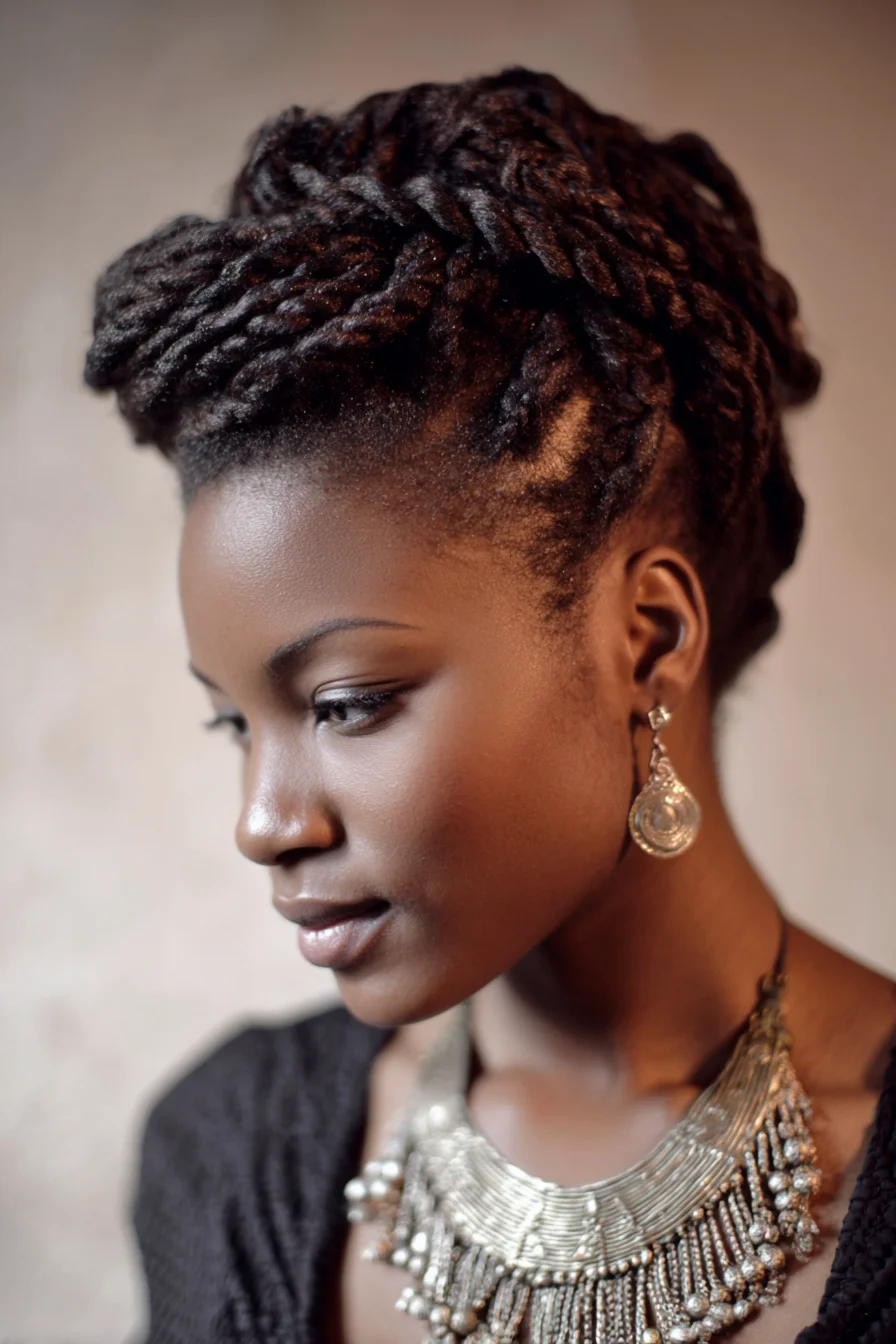
This elegant crown updo is created from chunky two-strand/rope twists and works best on Type 3C–4C natural hair or relaxed hair with enough density. Fine or low-density hair can achieve the look with pre-twisted extensions. Technique: work on freshly washed, detangled, and well‑moisturized hair. Section into large panels, apply a cream-based leave-in and twist‑defining product, then form two‑strand or rope twists. Roll and pin the twists around the crown, tucking ends neatly and securing with discrete bobby pins or small elastics for a smooth silhouette. Tools needed: rat‑tail comb, sectioning clips, small elastics, bobby pins (long and U‑pins), optional crochet needle for extensions, and a hooded dryer for setting. Products required: leave‑in conditioner, twisting butter or cream, light holding gel or edge control, lightweight oil or sheen spray, and a clarifying shampoo for periodic cleansing. Difficulty level: moderate — requires basic twisting skills and careful pinning; expect 45–90 minutes depending on length/extension work. Maintenance tips: sleep on a satin bonnet or pillowcase, refresh edges with water + leave‑in, resecure loose twists weekly, avoid overly tight tension to prevent breakage, and cleanse the scalp every 1–2 weeks.
Side Feed-In Cornrows Transitioning to a Loose Fishtail Braid for Textured Hair

Suitable for textured, coily and curly hair (3A–4C), this hybrid look works best on medium to thick strands and can be created with or without added extensions for extra length and volume. Begin on clean, detangled hair with a light leave-in; section and create neat feed-in cornrows along the crown toward one side, then gather the cornrow ends and transition into a larger three- or four-strand braid or fishtail. Slightly pancake the braid to open it up for a soft, voluminous finish and secure with a small elastic. Tools: rat-tail comb, sectioning clips, small elastics, boar-bristle brush and optional crochet needle for installing extensions. Products: moisturizing leave-in conditioner, lightweight styling cream or paste, edge-control gel, smoothing oil and a flexible-hold hairspray or mousse. Difficulty: intermediate — requires controlled feed-in braiding and blending skills if using extension hair. Plan 45–90 minutes depending on length and complexity. Maintenance tips: sleep on a silk scarf or bonnet, refresh the scalp with a light oil and a water/leave-in mist every 3–4 days, retouch edges as needed, avoid excessive tugging, and remove after 4–8 weeks to deep-condition and prevent breakage.
Double Dutch Cornrows Into Chunky Two-Strand Braids
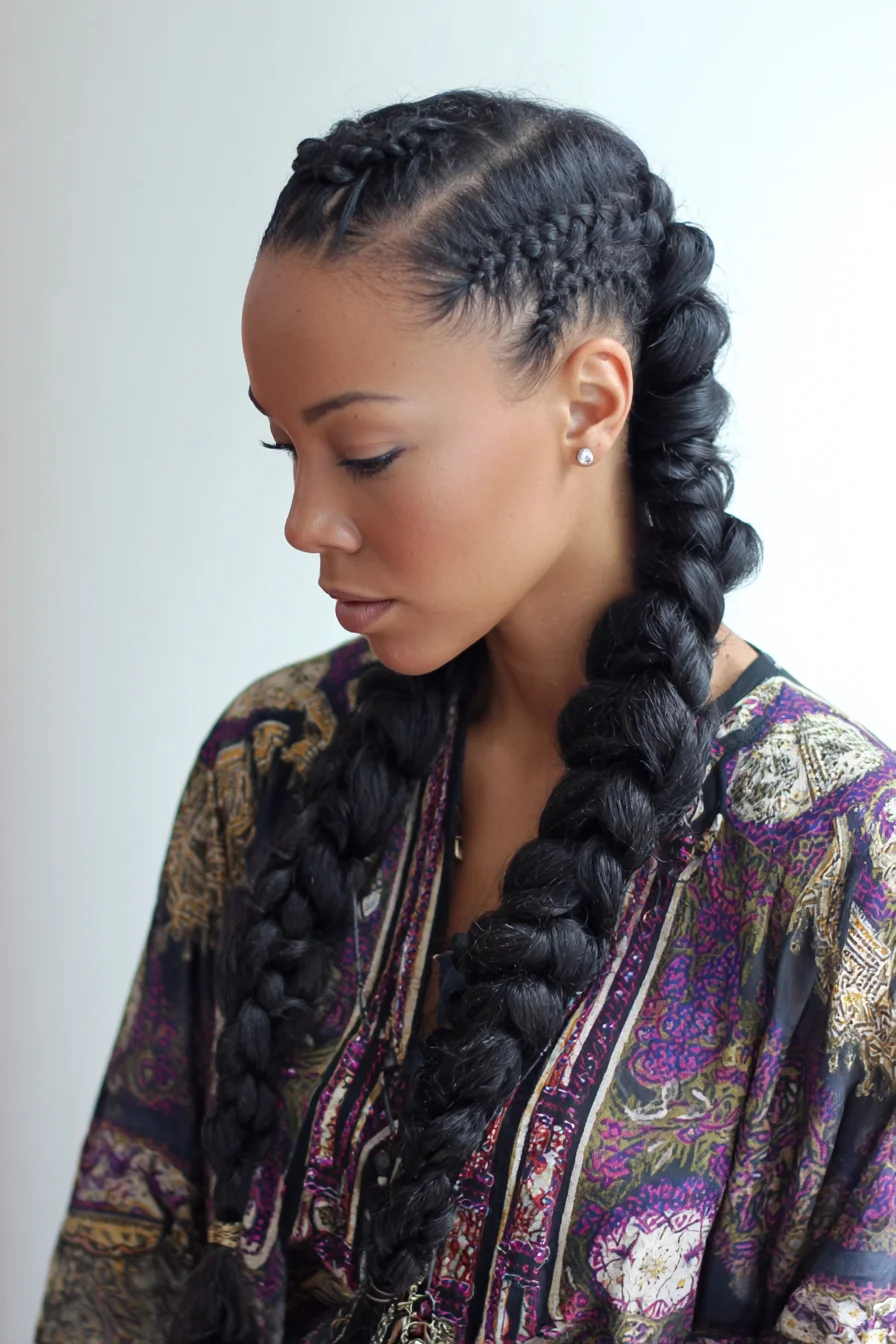
This polished protective style suits medium to very thick hair and long lengths; fine or shorter hair can achieve the same look with feed-in or clip-in extensions. Start on clean, detangled hair with a lightweight leave-in applied. Create a centered part and section into two panels. Using a rat-tail comb, Dutch-braid each panel from the hairline down to the nape, adding hair as you go to form neat cornrows. Secure the ends with small elastics and pancake each braid by gently pulling outer loops to widen and soften the shape for that chunky finish. Tools: rat-tail comb, sectioning clips, edge brush, small clear elastics, optional braid extensions or crochet hook. Products: leave-in conditioner, edge control or gel for a sleek hairline, lightweight oil or serum for shine, and a medium-hold hairspray or braid sheen. Difficulty: intermediate — requires consistent tension and braiding practice; allow 45–90 minutes. Maintenance tips: sleep with a silk scarf or bonnet, mist scalp and braids with braid spray twice weekly, refresh edges lightly with gel, avoid heavy oils that cause buildup, and plan to redo after 3–6 weeks depending on new growth.
High Half-Up Cornrows with Loose Textured Waves and Micro-Braids

Suitability: Best for textured, curly, or thick hair (3A–4C) where cornrows hold well; can also be adapted for straighter hair by adding texture with a sea-salt spray or light mousse. Styling technique: Section the top into small-to-medium triangular/rectangular parts and French/cornrow toward the crown, leaving side strands and ends unbraided for a relaxed look. Gather the cornrows into a high bun, secure with a strong elastic and pins, and allow several box/micro-braids and natural waves to fall around the face for contrast. Tools needed: rat-tail comb, sectioning clips, small elastics or hair ties, bobby pins, fine-tooth comb, and a light-duty crochet hook for added extensions. Products required: leave-in conditioner, lightweight styling cream or gel for holding braids, edge control, a light oil or serum for shine, and a flexible-hold hairspray to tame flyaways. Difficulty level: Intermediate — requires clean parting and consistent tension; consider a professional for tight, long-lasting cornrows. Maintenance tips: sleep on a silk/satin scarf, reapply scalp moisturizer every 3–4 days, smooth edges as needed, and expect to refresh or redo cornrows after 4–6 weeks depending on hair growth and looseness.
Straight-Back Cornrows Transitioning into Long Three-Strand Braids

This polished protective style pairs neat straight-back cornrows at the scalp with longer three-strand braids cascading down the back. Best suited to type 3–4 natural textures, it also works on straighter hair when pre-textured with a light curl or when using braiding extensions for grip. Technique: section hair with a rat-tail part, clip away unused sections, then create firm but not overly tight cornrows from the hairline toward the crown and continue each row into a regular three-strand braid or add extensions for length/thickness. Tools needed: rat-tail comb, sectioning clips, small elastics, water spray bottle, edge brush, and scissors (for trimming extensions). Recommended products: moisturizing leave-in conditioner, braid gel or light edge control for smooth parts, a light holding mousse to reduce frizz, and a non-greasy scalp oil or spritz for hydration. Difficulty: intermediate — requires clean parting and consistent tension; expect 2–4 hours depending on size/length. Maintenance tips: sleep with a silk/satin scarf or bonnet, lightly oil the scalp twice weekly, cleanse with diluted shampoo or scalp cleanser as needed, avoid overtightening during touch-ups, and remove within 6–8 weeks to prevent breakage.
As a professional, my best advice is to choose braided styles that match your hair health, daily routine, and maintenance willingness. For delicate or chemically treated hair, opt for looser, low-tension braids and give your scalp regular breaks between protective styles. Use sulfate-free shampoos, lightweight oils on ends, and a weekly deep-conditioning mask to maintain elasticity and shine. When styling at home, section carefully, work with clean but slightly textured hair, and invest in good-quality elastics and a fine-tooth comb for neat parts. If you want longevity, seal the ends with a small amount of heat or a drop of oil after braiding and sleep on a silk pillowcase or use a silk bonnet. If youre unsure which braid suits you best, book a consultation — I can assess texture, length, and face shape to recommend the perfect braid that looks great and keeps your hair healthy.

